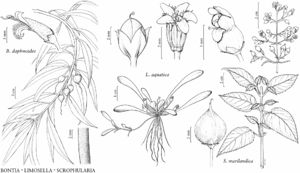Scrophularia
Sp. Pl. 2: 619. 1753.
| Taxon | Illustrator ⠉ | |
|---|---|---|
 | Bontia daphnoides Limosella aquatica Scrophularia marilandica | Barbara Alongi Barbara Alongi |
 | Scrophularia californica Verbascum virgatum Verbascum phlomoides | Linny Heagy Linny Heagy |
Subshrubs or herbs, annual or perennial; caudex herbaceous or woody; stolons absent. Stems erect, glabrous, glabrate, glandular-pubescent, puberulent, or villous. Leaves persistent, cauline, opposite, decussate; stipules absent; petiole present; blade not fleshy (fleshy in S. desertorum), not leathery, margins serrulate, serrate, dentate, or incised. Inflorescences terminal, panicles, sometimes axillary, cymes (S. peregrina); bracts present. Pedicels present; bracteoles present. Flowers bisexual; sepals 5, calyx radially symmetric, campanulate, lobes triangular-ovate to lanceolate; petals 5, corolla ± dark, often bicolored, red, black-red, brown-red, brick-red, purple-red, cream, or green, often paler abaxially, bilaterally symmetric, proximally inflated, distally constricted, abaxial lobes 1, lateral 2, adaxial 2; stamens 4, adnate to corolla near base, subdidynamous, filaments glandular-puberulent, staminode (0 or) 1, clavate to flabellate, sometimes rudimentary, scalelike or awnlike; ovary 2-locular, placentation axile; stigma capitate or 2-lobed. Fruits capsules, ± pear-shaped, dehiscence septicidal. Seeds 100–130+, black to brown, oblong-ovoid, rugose, wings absent.
Distribution
North America, n Mexico, West Indies, Europe, Asia (sw China), n Africa
Discussion
Species 150+ (11 in the flora).
Chromosome numbers of 2n = 18, 24, 26, 36, 40, 50, 52, 56, 58, 78, 80, 84, 86, 90, 92, and 96 have been reported for Scrophularia. Base chromosome numbers 7, 9, 10, 12, and 13 have been proposed for Scrophularia (see C. Carlbom 1969); a hypothesis for one distinct base number has yet to be presented.
Scrophularia nodosa Linnaeus, native to Europe, is discussed under 7. S. marilandica. European species S. aquatica Linnaeus (later referred to as S. umbrosa Dumortier), S. auriculata Linnaeus, and S. canina Linnaeus were reported on ballast in New Jersey, New York, and Pennsylvania in the 1870s and 1880s and are not known to have persisted.
North American scrophularias can become especially abundant in areas with human disturbance. Native American uses of Scrophularia were reported by D. E. Moerman (1998).
Scrophularias are visited, and presumably pollinated, by bees, wasps, and other insects. Scrophularia macrantha, with relatively showy, large, red corollas, is often cited as hummingbird-visited, and other species are hummingbird-visited as well; S. montana is a major nectar resource for migrant Selasphorus hummingbirds (D. Heinemann 1992).
Morphological plasticity in Scrophularia produces variation so wide as to make characters that have been used to define and separate some taxa of limited use. The most distinct species are of relatively narrow distribution.
Selected References
Lower Taxa
Key
| 1 | Inflorescences axillary, cymes. | Scrophularia peregrina |
| 1 | Inflorescences terminal, panicles. | > 2 |
| 2 | Pedicels densely villous. | Scrophularia villosa |
| 2 | Pedicels glabrate or stipitate-glandular. | > 3 |
| 3 | Corollas bright red, (10–)13–21 mm. | Scrophularia macrantha |
| 3 | Corollas black-red, brown-red, brick red, red, purple-red, green, or cream, 5–12(–14) mm. | > 4 |
| 4 | Corollas black-red, throats constricted. | Scrophularia atrata |
| 4 | Corollas brown-red, brick red, red, purple-red, green, or cream, throats open or narrow. | > 5 |
| 5 | Herbage light gray-green (fresh leaves fleshy); corollas bicolored, sometimes unicolored, paler abaxially (abaxial lobe often cream to white). | Scrophularia desertorum |
| 5 | Herbage light green to dark green (fresh leaves not fleshy); corollas unicolored or ± bicolored, paler abaxially. | > 6 |
| 6 | Leaf blade margins regularly serrulate or serrate. | > 7 |
| 7 | Pedicels relatively stout; petiole lengths 1/12–1/6 blades; blades 8.5–14 cm, lengths 3–4.5 times widths, bases truncate or cuneate, margins regularly serrulate. | Scrophularia montana |
| 7 | Pedicels slender; petiole lengths 1/3–1/2 blades; blades 10–19(–25) cm, lengths 2–3 times widths, bases rounded to cordate, margins regularly serrate. | Scrophularia marilandica |
| 6 | Leaf blade margins serrate, dentate, and/or incised. | > 8 |
| 8 | Herbage puberulent or glabrate; leaf blades 4–7(–8) cm. | > 9 |
| 9 | Herbage puberulent, more densely distally; petiole lengths 1/6–1/3 leaf blades. | Scrophularia parviflora |
| 9 | Herbage glabrate; petiole lengths 1/3–1/2 leaf blades. | Scrophularia laevis |
| 8 | Herbage glandular-pubescent, rarely glabrate; leaf blades 8–17(–20) cm. | > 10 |
| 10 | Staminodes yellow-green, sometimes green to brown-red, flabellate, lengths less than widths. | Scrophularia lanceolata |
| 10 | Staminodes red, brown-red, or green, clavate to obovate, lengths greater than widths. | Scrophularia californica |